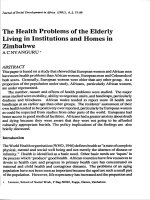Dermatoethics Contemporary Ethics and Professionalism in Dermatology ppt
Bạn đang xem bản rút gọn của tài liệu. Xem và tải ngay bản đầy đủ của tài liệu tại đây (2.92 MB, 265 trang )
Dermatoethics
Lionel Bercovitch • Clifford Perlis
Editors
Dermatoethics
Contemporary Ethics
and Professionalism in Dermatology
Editors
Lionel Bercovitch, MD
Departments of Dermatology
Hasbro Children’s Hospital
and Rhode Island Hospital
Warren Alpert Medical
School of Brown University
Providence, RI, USA
Clifford Perlis, MD, MBe
Fox Chase Cancer Center
Philadelphia, PA, USA
ISBN 978-1-4471-2190-9 e-ISBN 978-1-4471-2191-6
DOI 10.1007/978-1-4471-2191-6
Springer London Dordrecht Heidelberg New York
British Library Cataloguing in Publication Data
A catalogue record for this book is available from the British Library
Library of Congress Control Number: 2011940767
© Springer-Verlag London Limited 2012
Apart from any fair dealing for the purposes of research or private study, or criticism or review, as per-
mitted under the Copyright, Designs and Patents Act 1988, this publication may only be reproduced,
stored or transmitted, in any form or by any means, with the prior permission in writing of the publish-
ers, or in the case of reprographic reproduction in accordance with the terms of licences issued by the
Copyright Licensing Agency. Enquiries concerning reproduction outside those terms should be sent to
the publishers.
The use of registered names, trademarks, etc. in this publication does not imply, even in the absence of a
specifi c statement, that such names are exempt from the relevant laws and regulations and therefore free
for general use.
Product liability: The publisher can give no guarantee for information about drug dosage and application
thereof contained in this book. In every individual case the respective user must check its accuracy by
consulting other pharmaceutical literature.
Printed on acid-free paper
Springer is part of Springer Science+Business Media (www.springer.com)
To my parents, Solomon Bercovitch and Claire and Marcus Tessler
from whom I acquired my values
To my mentors and professional role models, Charles McDonald,
MD, Bencel Schiff, MD, and Manly Rubin, MD, from whom I
acquired my love of dermatology
And to my family–Anne, Deb, Rob, Rhana, Ryden, Paul, Rains, and
Carol, whose love and support have sustained me through this project
and make every day a joy.
— LB
For my parents, Linda and Barry R. Perlis, whose patience and
encouragement are limitless.
For my teachers and colleagues, Charles McDonald, MD, Jonathon
Merz, PhD, JD, and Stuart Lessin, MD who continue to inspire and
support my academic endeavors.
For the endless understanding of my wife, Emily, and love of my
children, Elliot and Gabrielle.
—CSP
vii
Foreword
As a teacher of residents, a colleague of fellow academic dermatologists, and a past
president of our national specialty society, I have witnessed a large array of ethical
dilemmas. Controversy on how to teach the issues and guide our young people regard-
ing their future choices has been discussed repeatedly in forums ranging from
American Academy of Dermatology forums to Association of Professors of
Dermatology panels. I have personally found the best method to raise consciousness
in ethical decision-making to be real life situations, issues faced in everyday clinics,
in business management, and in scholarly pursuits.
Apparently Drs. Bercovitch, Perlis, and co-authors in the book Dermatoethics
agree. In framing each of their over 40 chapters they elect to start with a series of
scenarios which illustrate the problems encountered in each area, then review relevant
AMA or AAD or guidelines, speak to the appropriate ethical principles, and end with
a thorough discussion of ways each scenario might be resolved. This format makes
the book a relatively easy read while tackling the most challenging of issues.
In sum, there is no other book like it. Dermatoethics helps us prepare to face tough
decisions. In prospectively considering these diverse situations we can be more criti-
cal consumers of the medical literature, models of transparency, and physicians who
see the issues through the eyes of our patients. It is this perspective that should guide
our actions, and Dermatoethics doesn’t let us deviate from this patient-centeredness.
Bravo! Read, refl ect and enjoy humanistic medicine at its best.
Department of Dermatology William D James, MD
University of Pennsylvania School of Medicine
Philadelphia, PA
ix
Preface
What would you do if a dermatopathology laboratory offered to pay 85% of the cost
of an expensive electronic health record system for your practice? What if a patient
asked you to accept an invitation to become a Facebook friend? What would you do
if you saw a lesion you suspected might be melanoma on the back of a stranger get-
ting dressed two lockers over at the gym? And, what would you do if one of your
associates began to exhibit early signs of dementia?
These are examples of the many contemporary ethical and professional dilemmas
dermatologists and dermatology trainees might face in their day-to-day work. The
solutions are more nuanced than they may appear to be at fi rst glance. Fortunately,
dermatologists do not need to be trained bioethicists, healthcare lawyers, or philoso-
phers to analyze and deal with such dilemmas. Nor do they need to have a ready
solution for every ethical dilemma encountered. Dermatologists do need to recognize
when an ethical issue or dilemma arises, identify key issues, assess relevant ethical
principles as well as legal and professional issues, seek advice and supplementary
information when indicated, and attempt to resolve the issue in a sound and satisfying
way. This approach is illustrated in Fig. 1.
Behavioral ethicists emphasize the importance of honing one’s skills in ethical
analysis to avoid self-deception. “When we fail to notice that a decision has an ethical
ANALYZING A PROBLEM OR DECISION
IRRESOLVABLE CONFLICT OR
LAW UNCLEAR-MAY NEED
COURT TO RESOLVE
JUSTIFY THE
DECISION WITH SOUND
ARGUMENTS
RESOLVED NOT RESOLVED
SUBJECT THE DILEMMA TO CRITICAL ANALYSIS
IDENTIFY RELEVANT LEGAL, PROFESSIONAL GUIDANCE
SEEK ADDITIONAL INFO INCLUDING PATIENT’S VIEWPOINT
BREAK DILEMMA DOWN TO ITS COMPONENT PARTS
RECOGNIZE EXISTENCE OF AN ETHICAL DILEMMA OR PROBLEM
Fig. 1 The approach to an ethical dilemma (Adapted from p. 8, Medical Ethics Today the BMA’s
handbook of ethics and law. 2nd ed. BMJ Books. London, 2004)
x Preface
component, we are able to behave unethically while maintaining a positive self-
image,” write Max Bazerman and Ann Tenbrunsel in a recent New York Times article
(April 21, 2011, p. A27). Furthermore, they add, “research shows that people consis-
tently believe themselves to be more ethical than they are … (and) that people who
have a vested self-interest, even the most honest of us, have diffi culty being objective.
Worse yet, they fail to recognize their lack of objectivity.” Since all physicians have
vested self-interests, confl icts of interest are inherent in the practice of medicine.
Accordingly, research suggests that even the most ethically aware physicians may not
realize their own subjectivity.
This concept of this book arose from a regular seminar entitled “ Dermatoethics ” in
the Brown University dermatology residency, led by one of the editors (L.B.), that
began in 2001. At that time, our faculty recognized the irony that educational offerings
in ethics were abundant for medical students, but virtually non-existent for residents
who for the fi rst time actually have meaningful independent responsibility for patient
care. Furthermore, each year the seminar identifi ed new situations refl ecting the ever-
changing medical environment. Electronic communication, social networking, health-
care reform, the changing reimbursement scene, consumerism and the business of
medicine, cosmetic dermatology and medical spas, and advances in genetic technol-
ogy, all give rise to new ethical concerns. These developments combined with the
frailties of human nature, to which physicians are not exempt, underscore the need for
ongoing teaching and dialogue on contemporary issues in ethics and professionalism
for dermatology trainees and practitioners.
From 2001 to 2010, 136 English-language articles on ethics in dermatology were
published. By contrast, there were only 98 articles published over the prior 20 years.
The American Academy of Dermatology offered four forums and discussion groups
on ethics at its 2011 meeting. There has clearly been increasing interest in ethical
issues in dermatology. It is our hope that this book will serve as a resource to stimu-
late discussion and teaching in ethics to dermatology trainees, as well as for practic-
ing dermatologists in academia, public and military service, and the community.
No work of this scope can be accomplished without the help and support of others.
We wish to acknowledge the encouragement, foresight and patience of the publish-
er’s senior editor, Grant Weston, as well as the tireless work of our production editor,
Rebecca McArdle, in keeping tabs on all the contributors, chapters, permissions, and
fi gures. We are also grateful for the administrative support of Allison Marshall, Dawn
Elder, and Kathy Zenszer. Our contributors good-humoredly and willingly allowed
their work to be subjected to numerous edits and rewrites, and the fi nal product in no
small measure refl ects their diligence and persistence. We thank Dr. Antonio P. Cruz
for his assistance with technological challenges, usually with little notice. George
Wakeman, Esq. provided insightful legal commentaries as helpful background to
many of the chapters, as nearly all the chapters did not have authors with legal train-
ing. We would be remiss in failing to acknowledge the contributions of our former
residents at Brown who were the experimental group for this project (N = 37) and the
foresight of Charles McDonald, M.D., Professor and Chairman of Dermatology at
Brown University, who encouraged the establishment of this seminar course. And
lastly, to our spouses and children, who sacrifi ced many hours of quality time with us
during the preparation of this book, we are grateful beyond words.
Lionel Bercovitch, M.D.
Clifford Perlis, M.D., MBe
xi
What Do We Mean by Ethical?
Clifford Warren Lober
D e fi nition of Ethics
Although we all use the term ethics (or ethical), there has been great diffi culty and
lack of clarity in defi ning this term. It is often used interchangeably with words such
as “good”, “right”, “acceptable”, or “ideal”. Many texts defi ne ethics in terms of
“morals”, “moral life,” or “moral philosophy” [1, 2]. There is, however, an inherent
paradox in defi ning ethical as “moral” or “good”. If, for example, one accepts the
defi nition of ethical as “moral” and in turn looks up the defi nition of “moral”, one
may fi nd “morality” defi ned (among other descriptions) as “a system of rules, ethics”
[3]. This circular defi nition both fails to clarify the meaning of either ethics or morals
and, perhaps more importantly, provides absolutely no guidance for determining
whether a given action is ethical or moral.
If one searches for the defi nition of ethics in Black’s law dictionary, we are told to
“see legal ethics” [4]. Legal ethics in turn is defi ned as “the standards of minimally
acceptable conduct within the legal profession…” [5] We are again confronted with
problems. Are ethical standards “minimally acceptable conduct”, or are they rather
ideals toward which one should aspire? Furthermore, this defi nition again gives us no
basis for determining whether a given action is ethical.
The following defi nition of ethics is therefore proposed: ethics is a set of behav-
ioral ideals derived from fundamental beliefs. These beliefs are either (1) arbitrarily
accepted as true in and of themselves or (2) derived inductively or deductively from
other fundamental beliefs . Let us examine this defi nition closely.
Ethics represents behavioral ideals which describe behaviors and actions, not
things. The moon or a tree, for example, is neither ethical nor unethical. Inherent in
this defi nition is the fact that these behaviors have to be the intentional actions of
people. A horse pulling a cart or the actions of a profoundly mentally impaired person
are similarly neither ethical nor unethical.
Ethics are not minimally acceptable behaviors, but rather ideals or goals to which we
should strive. The Code of Medical Ethics of the American Academy of Dermatology,
for example, clearly presents ideals to which we should strive since it “espouses a stan-
dard of behavior that is, in some cases, higher than that required by the law” [6].
Our ethical actions are based upon our fundamental beliefs. These beliefs are the
basic bedrock, core, foundational beliefs that one holds, such as the belief in the exis-
tence of God to a religious person. They are beliefs, by which we mean values that
are accepted as true or the “given” in a hypothetical situation. It is obviously critical
that any defi nition of ethics address how we arrive at these beliefs.
There are three ways one can arbitrarily accept beliefs to be inherently fundamen-
tally true. They can be described as self-evident or innately obvious. The Declaration
xii What Do We Mean by Ethical?
of Independence, for example, states that “We hold these truths to be self-evident , that
all men are created equal, that they are endowed by their Creator with certain unalien-
able Rights, that among these are Life, Liberty, and the pursuit of Happiness.”
[emphasis added] These truths were not scientifi cally proven or reasoned by deduc-
tive or inductive thinking, but were rather innately obvious to the framers of the
Declaration and accepted as fundamentally true.
Divine pronouncement is another way we arbitrarily accept beliefs to be funda-
mentally correct. God is perfect and therefore anything He says is accepted as abso-
lute truth. Period. Statements made in religious texts attributed to God are clear
examples of divine pronouncement. To those who believe that “God transcends all
human reality and is without limit,” His word is absolute [7].
Finally, beliefs may be arbitrarily accepted as core values because they are socio-
biologically necessary or adaptive. For example, I will probably not want to lie to you
because you may never believe me again and I will not be able to trust statements
made by you since you may now feel free to be dishonest with me. Therefore, it is not
socially benefi cial for me to lie to you.
Fundamental beliefs may also be derived by either inductive or deductive reason-
ing. When using inductive reasoning, we generalize from a sample to a universal
value or reasoning from specifi c instances to general propositions. For example, sav-
ing a particular patient’s life is ethically correct; therefore saving all patients’ lives is
ethical. Alternatively, in deductive reasoning the conclusion is arrived at in a step-by-
step manner and the conclusion necessarily follows as a logical consequence of the
premises. For example, the death sentence is unethical. Lethal injection is a form of
the death sentence. Therefore, lethal injection is unethical when used to carry out a
death sentence.
Characteristics of Ethics
Ethics facilitates the functioning of society. It is obvious how rejecting killing, steal-
ing, or lying as unethical promotes an orderly society. As Odell stated, “Ethics is a
social phenomenon. If we did not live in communities, ethics would lose its point.
From the perspective of community, the goal of ethics is to make it possible for us to
live together. …The production of harmonious co-existence is and must be the role of
a system of ethics” [8].
Ethics are inherently subjective. If we alter our fundamental beliefs, our ethical
values change. If we fundamentally believe that human life is sacred, the death pen-
alty is obviously unethical. Alternatively, if we accept that society should seek “an
eye for an eye,” the death penalty would be ethical.
Ethics will differ in various societies. Many ancient cultures considered human
sacrifi ce to the gods to be a high honor. Most contemporary Americans, conversely,
would be horrifi ed at the thought of sacrifi cing another human being for any reason.
Ethics depends on the amount of detail one is given about a particular situation. If
I tell you that I am going to rob a bank, you may fi nd this action unethical. However,
if I tell you that I plan to commit this robbery because my children are starving and
that I have absolutely no other means of obtaining money to buy food other than rob-
bing a bank, my action may become less ethically objectionable. Similarly, one may
fi nd it unethical to deny treating a patient who has a superfi cial basal cell carcinoma.
However, if it is subsequently revealed that the same patient has metastatic pancreatic
cancer and has a life expectancy of only a few months, allowing the skin cancer to go
What Do We Mean by Ethical? xiii
untreated may seem far less unethical. In fact, not treating the skin cancer may be the
most ethical approach in this situation.
Ethics is not the same as a code of laws. Laws are actions taken by elected or
appointed groups of persons to govern society. It is not surprising, therefore, that each
law may be viewed as ethical or unethical depending upon one’s beliefs. If, for exam-
ple, you strictly oppose abortion you will fi nd statutes permitting abortion to be
highly unethical. Conversely, if you support abortion the same law may be ethical in
your view. One should absolutely never state either that an action is ethical because
it is legal or that a behavior is unethical because it is illegal.
There will rarely be universal agreement on ethical values. This is merely a refl ec-
tion that different individuals and societies will hold quite different fundamental
beliefs.
Ethical confl icts exist and are unavoidable. One may believe, for example, that it
is ethically wrong to torture a person and simultaneously believe that human life is
sacrosanct. If, hypothetically, a terrorist plants a bomb in a shopping center and the
only way to learn the location of the bomb and save dozens of innocent lives is to
torture the terrorist, the determination of whether or not to torture the terrorist pres-
ents a very obvious ethical confl ict. Ethical confl icts are usually resolved by examin-
ing the relative strengths of the underlying fundamental beliefs upon which the ethical
actions are founded.
Ethics is often communicated using concepts such as good vs. bad, right vs. wrong,
desirable vs. undesirable, or moral correctness. Although these terms may character-
ize ethics, they should not be used to defi ne ethics for previously described reasons.
Ethics changes with time due to changes in our fundamental beliefs. The American
Medical Association’s 1847 Code of Ethics, for example, stated that “[i]t is deroga-
tory to the dignity of the profession to resort to public advertisements or private cards
or handbills, inviting the attention of individuals affected with particular diseases…
These are the ordinary practices of empirics and are highly reprehensible in a regular
physician” [9] [emphasis added]. This statement no longer appears in the AMA’s
Code of Ethics.
Ethics Is Not Objectively Provable
Many people are bothered by the fact that ethics is not objectively provable, in con-
trast to the temperature at which water boils or the distance to the moon. This objec-
tion, however, fades away when one considers that all knowledge, both scientifi c and
ethical, is of necessity based upon assumptions.
For centuries it was believed that the earth was both fl at and the center of the solar
system. People were burned alive at the stake for denying these very obvious “facts”.
Many schools still teach that there are 180° in a triangle, despite our realization that
this “fact” applies only in rare, theoretical instances where space-time is not curved
by the existence of matter [10]. Dermatopathologists on a daily basis make diagnostic
determinations using microscopes. Although none of us would seriously dispute the
existence of optical distortion in all microscopic lenses, we routinely rely on these
fl awed instruments to make “objective”, diagnostic determinations.
The key point is that just as our ethics are based upon fundamental assumptions,
so-called “scientifi c” or “objective” statements are similarly made based upon
assumptions or beliefs. As Brentano stated, “In a science it is not possible to prove
every opinion which we set forth. For every proof rests upon certain presuppositions;
xiv What Do We Mean by Ethical?
if we prove these, it is upon the basis of still further presuppositions. But this process
cannot go on forever. We cannot avoid this infi nite regress by arguing in a circle, for
then we simply explain the term in question by means of the same term, but in a dis-
guised form. … Hence we must start with unproven principles, with immediate
assumptions” [11]. It is similarly incorrect to discount the validity of ethical assump-
tions merely because they cannot be “scientifi cally” or “objectively” validated.
Where Does This Leave Us?
Given the above defi nition of ethics and an understanding of the characteristics of
ethics, we are in a far better position to consider individual situations and make ethi-
cal determinations. We know that our ethics are subjective, will refl ect our fundamen-
tal beliefs, differ among various individuals, depend upon the amount of detail we are
given, etc. We clearly understand that the fact an action is legal or illegal does not
necessarily mean it is ethical. It is critical that in describing any behavior as ethical
we address the fundamental underlying belief that we feel justifi es that behavior and
the reason we accept that underlying belief as true or correct. Finally, we recognize
that neither ethical nor “scientifi c” beliefs are absolute.
Acknowledgment
Presented in part on March 6, 2010 at the 68th Annual Meeting of the American
Academy of Dermatology in Miami, Florida
References
1. Principles of biomedical ethics. 5th ed. In: Beauchamp TL, Childress JF, editors.
Oxford: Oxford University Press; 2001. p. 1.
2. Historical dictionary of ethics. In: Gensler HJ, Sprugin EW, editors. Lanham, MD:
The Scarecrow Press, Inc.; 2008. p. xi.
3. Black’s law dictionary. 7th ed. In: Garner BA, editor. St. Paul: West Group; 1999.
p. 1025.
4. Id., p. 573.
5. Id., p. 904.
6. AAD Code of Medical Ethics for Dermatologists, 2010. />Forms/Policies/Uploads/AR.pdf . Accessed 1 Mar 2010.
7. Reed ED. The genesis of ethics, on the authority of God as the origin of Christian
ethics. Chapter One: the authority of God: God as author. Cleveland: The Pilgrim
Press; 2000. p. 1.
8. Odell SJ. On consequentialist ethics. Australia: Thompson Wadsworth; 2004. p. 4.
9. Code of Ethics of the American Medical Association, 1847. -assn.
org/ama/pub/about-ama/our-history/history-ama-ethics.shtml . Accessed 1 Mar 2010.
10. Gueron E. Adventures in curved spacetime. Sci Am. 2009;301:38–45.
11. Brentano F. The foundation and construction of ethics. Chapter 1: The extent to
which principles of knowledge can be an object of investigation and controversy.
New York: Humanities Press; 1973. p. 14.
xv
Contents
Part I Dermatologist as Clinician
1 “Excuse Me…”: Unsolicited Dermatologic Opinions:
Ethical, Moral, and Legal Issues . . . . . . . . . . . . . . . . . . . . . . . . . . . . . . . . . . 3
Lionel Bercovitch
2 “Give Me Enbrel™ or Give Me Death”:
Confronting the Limits of Autonomy. . . . . . . . . . . . . . . . . . . . . . . . . . . . . . . 9
Lionel Bercovitch
3 Direct-to-Consumer Advertising of Prescription
Medications: Misguided “Autonomy” in the Information Age . . . . . . . . . 13
Lisa Pappas-Taffer and Alexander Miller
4 Autonomy, Isotretinoin and iPLEDGE:
The Ethics of Burdensome Regulation
and Use of Teratogenic Medication . . . . . . . . . . . . . . . . . . . . . . . . . . . . . . . 19
Kenneth E. Bloom and Lionel Bercovitch
5 “Who Speaks for the Child?” Consent, Assent,
and Confi dentiality in Pediatric Dermatology. . . . . . . . . . . . . . . . . . . . . . . 25
Kenneth E. Bloom and Lionel Bercovitch
6 Therapeutic Privilege: If, When, and How to Lie to Patients . . . . . . . . . . 33
Richard G. Fried and Clifford Perlis
7 Communicating with Patients About Adverse
Medical Events: If, When, and How to Say “I’m Sorry”. . . . . . . . . . . . . . 37
Steven Shama, Lyn Duncan, and Lionel Bercovitch
8 The Computer Will See You Now: Ethics of Teledermatology . . . . . . . . . 45
Jennifer L. Weinberg, Rachel H. Gormley, and Carrie L. Kovarik
9 Hospital Consultations: Embracing
Professionalism Even When It Hurts. . . . . . . . . . . . . . . . . . . . . . . . . . . . . . 51
Lauren E. Krug and Stephen E. Helms
10 The Extender Is In: Delegating Ethically—Ethical
and Professional Issues Relating to Physician
Extenders in Dermatology. . . . . . . . . . . . . . . . . . . . . . . . . . . . . . . . . . . . . . . 55
Steven Rosenberg and Clifford Perlis
xvi Contents
Part II Dermatologist as Professional
11 Professional Boundaries:
Safeguarding the Physician–Patient Relationship . . . . . . . . . . . . . . . . . . . 61
Brandon H. Krupp
12 Taking Care of Uncle Bob’s Rash:
Should One Treat Family Members?. . . . . . . . . . . . . . . . . . . . . . . . . . . . . . 67
Sandra Osswald
13 Peering into the Gift Horse:
Is It Ethical to Accept Gifts from Patients?. . . . . . . . . . . . . . . . . . . . . . . . . 71
Lionel Bercovitch
14 The Dermatologist and Social Media:
The Challenges of Friending and Tweeting . . . . . . . . . . . . . . . . . . . . . . . . . 77
Jennifer A. Sbicca and Stanton K. Wesson
15 Respecting Differences: Dermatology in a Diverse Society . . . . . . . . . . . . 83
Vimal Prajapati and Benjamin Barankin
16 Dermatologists Within, Beyond
and Struggling with Borders: The Global Dermatologist . . . . . . . . . . . . . 91
Jennifer L. Weinberg
17 Feet of Clay: The Impaired Dermatologist . . . . . . . . . . . . . . . . . . . . . . . . . 97
Brandon H. Krupp
Part III Dermatologist as Teacher and Trainee
18 The Mentor-Mentee Relationship: The Devil Is in the Details . . . . . . . . 109
Kimberly L. Merkel, John A. Cole, and Stanton K. Wesson
19 Tales from the Residency Interview Trail . . . . . . . . . . . . . . . . . . . . . . . . . 113
Jennifer A. Sbicca and Alfred T. Lane
20 Ethics Education for Residents:
Growing Pains and Learning Crises . . . . . . . . . . . . . . . . . . . . . . . . . . . . . 119
Irèn Kossintseva and Benjamin Barankin
21 Teaching Ethics in Clinic: Keeping You Smart and Honest. . . . . . . . . . . 125
Nely Z. Aldrich and Eliot N. Mostow
Part IV Dermatologist as Businessperson
22 Boutiques, Botox
®
, and Basal Cells:
Can Dermatology Set Its Priorities? . . . . . . . . . . . . . . . . . . . . . . . . . . . . . 131
Jeffrey J. Meffert and Maria Villegas
23 The Price Is Right:
Offi ce Dispensing and Product Pricing . . . . . . . . . . . . . . . . . . . . . . . . . . . 137
Tivon Sidorsky
Contents xvii
24 My Elixir, MD:
Morphing a Medical Degree into a Skincare Brand. . . . . . . . . . . . . . . . . 143
Julie Cantor
25 Marketing the Physician: From Antitrust to Distrust . . . . . . . . . . . . . . . 147
Catherine L. Kowalewski and Jeffrey J. Meffert
26 What the Market Will Bear?
Ethical and Professional Issues in Medical Fees . . . . . . . . . . . . . . . . . . . . 153
Carl Johnson and Lionel Bercovitch
27 Spa, MD: When Dermatology Meets Aromatherapy . . . . . . . . . . . . . . . . 157
Tivon Sidorsky and Lionel Bercovitch
28 Gatekeepers, Dermatologists, and Their Patients:
Mixed Messages in Managed Care. . . . . . . . . . . . . . . . . . . . . . . . . . . . . . . 163
Lindsey A. Brodell, Robert T. Brodell, and Brendan Minogue
29 Ethical Adventures in 21st Century Dermatopathology . . . . . . . . . . . . . 169
Homer O. Wiland IV, Barry D. Kels, and Jane Grant-Kels
30 Defi ning the Gray Zone:
Client Billing and Contractual Joint Ventures . . . . . . . . . . . . . . . . . . . . . 177
Homer O. Wiland IV, Barry D. Kels, and Jane Grant-Kels
31 No Strings Attached? Managing Confl icts
of Interest in Medicine. . . . . . . . . . . . . . . . . . . . . . . . . . . . . . . . . . . . . . . . . 185
Noah D. Shannon and Clifford Perlis
Part V Dermatologist as Scholar
32 Respecting Human Subjects:
Responsibilities of the Clinical Investigator . . . . . . . . . . . . . . . . . . . . . . . 193
Kenneth Katz and Samual Garner
33 Hope, Hype, and Genotype:
Genetic Testing in Dermatological Diseases . . . . . . . . . . . . . . . . . . . . . . . 197
Natasha Shur
34 Desperate Measures for Desperate Patients:
Translational Research in Epidermolysis Bullosa. . . . . . . . . . . . . . . . . . . 205
Alfred T. Lane
35 Reading Between the Lines:
Can Peer Reviewers Be Expected to Detect Fraud? . . . . . . . . . . . . . . . . . 215
Jason D. Gillum, Jeffrey D. Bernhard, and Robert P. Dellavalle
36 Hiding Behind the Curtain:
Anonomyous Versus Open Peer Review . . . . . . . . . . . . . . . . . . . . . . . . . . 221
Andrea L. Suárez, Jeffrey D. Bernhard,
and Robert P. Dellavalle
xviii Contents
37 Ghost Busting in Dermatology Publications:
Providing Byline Integrity. . . . . . . . . . . . . . . . . . . . . . . . . . . . . . . . . . . . . . 227
Andrea L. Suárez, Jeffrey D. Bernhard, and Robert P. Dellavalle
38 Telling the Same Tale Twice:
Déjà vu and the Shades of Grey in Self-Plagiarism . . . . . . . . . . . . . . . . . 233
Andrea L. Suárez, Jeffrey D. Bernhard, and Robert P. Dellavalle
39 Cutting Edge or Cutting Corners? Innovative Care. . . . . . . . . . . . . . . . . 237
Jolion McGreevy and Clifford Perlis
Index . . . . . . . . . . . . . . . . . . . . . . . . . . . . . . . . . . . . . . . . . . . . . . . . . . . . . . . . . . 241
Part I
Dermatologist as Clinician
3
L. Bercovitch and C. Perlis (eds.), Dermatoethics,
DOI 10.1007/978-1-4471-2191-6_1, © Springer-Verlag London Limited 2012
1
“Excuse Me…”: Unsolicited
Dermatologic Opinions:
Ethical, Moral, and Legal Issues
Lionel Bercovitch
Case Scenarios
Case 1 (below). What would say if you saw this on
your daughter’s best friend?
Case 2 (below). What would you do if you saw this
lesion on the arm of a complete stranger in the health
club locker room?
L. Bercovitch
Department of Dermatology , Warren Alpert Medical School
of Brown University , Providence , RI , USA
e-mail:
Fig. 1.1 Photo courtesy reproduced
with permission
Fig. 1.2 Photo courtesy of Arthur Sober, M.D.
4 L. Bercovitch
Case 3 (below). What would you do if you saw this
on the fi nger of the barista serving you coffee at
Starbucks?
Case 4 (below). What would you do if you were
standing next to this person at the subway station while
waiting for a train?
Case 5 (below). Would you say something if you
saw these lesions while a mother was changing her
baby’s diaper at the beach? Would it be different if the
mother were a family friend?
Discussion
When is a dermatologist not a dermatologist? On vaca-
tion? At a family gathering? While exercising at the
gym? At the theater or waiting for a subway? In reality,
never. Dermatologists are skillful trained observers.
Even without the “antenna raised”, they observe lesions
and rashes on friends, relatives, and even complete
strangers that in the context of an established doctor–
patient relationship would demand attention and
action, possibly urgently. But what should the derma-
tologist do when individual in question is not a patient
and has not sought the doctor’s opinion? Should he or
she offer an unsolicited diagnosis or advice? What if
the consequences of inaction could be serious or even
fatal for the “patient”?
Fig. 1.4
Fig. 1.3 Photo
courtesy of Nathaniel
Jellinek, M.D.
Fig. 1.5
51 “Excuse Me…”: Unsolicited Dermatologic Opinions: Ethical, Moral, and Legal Issues
Although offering an unsolicited medical opinion
may be regarded as an act of benefi cence, the physi-
cian does not have a strict moral obligation to do so
[ 1 ] . On one end of the spectrum are conditions or
actions that are well recognized as being harmful but
that pose no immediate threat to the individual, such as
obesity, smoking, excessive sun exposure or indoor
tanning. On the other end are urgent, life-threatening
emergencies such as an accident or cardiac arrest. In
the former, the physician is not morally bound to offer
his opinion or to take action while in the latter, the phy-
sician is professionally and morally bound to act. In
the situations in between, in which the obligation of
benefi cence may exist, the physician may use his or
her discretion in deciding how, when, or even whether
to offer an unsolicited opinion [ 1 ] .
The degree to which the physician is morally obli-
gated to act is affected by the seriousness and urgency
of the risk to the individual, the degree of certainty of
the diagnosis, and the presumption that the stranger
would want the physician’s opinion or intervention [ 1 ] .
The more serious the consequences of inaction, the
less certain the diagnosis needs to be before acting.
The obligation to bring a diagnosis to someone’s
attention also depends on how obvious it is to that indi-
vidual that something is wrong. In addition, one cannot
assume that the person either knows how to access
medical care or that the condition is even treatable.
Unless the problem is treatable, there should be no obli-
gation to offer an unsolicited opinion [ 1 ] . Indeed, offer-
ing an unsolicited diagnosis for a condition that is
untreatable or for which no benefi cial intervention
exists could confl ict with the physician’s obligation of
non-malefi cence were the patient to suffer psychologi-
cal distress or act in a self-destructive way.
A latent diagnosis that may remain so before caus-
ing harm imposes greater moral obligation upon the
dermatologist. The bystander physician should possess
appropriate medical knowledge to render an opinion,
but need not be a specialist in the fi eld. A psychiatrist
can suspect a melanoma [ 2 ] and a dermatologist can
recognize exophthalmos as a sign of Graves’ disease
or suspect a potential cardiac emergency.
Even where there appears to be a professional obliga-
tion or duty to offer unsolicited advice, ordinary morality
(such as “don’t invade someone’s privacy”) may clash
with professional morality (the obligation to heal the sick
and relieve suffering). One’s personal morals and ethics
may confl ict with one’s professional duty and ethics [ 3 ] .
Ratzan [ 3 ] has described the “bystander phenome-
non” as it applies to medical emergencies, summarized
in Table 1.1 . Even so, the likelihood of the “bystander”
taking action may depend on the number of bystanders,
so-called “diffusion of responsibility” [ 3 ] , to which any-
one who has been present at a cardiac arrest can attest.
The bystander role can be ambiguous. How severe or
urgent is the situation? Is there a threat of harm increas-
ing with time and resulting from the bystander’s inac-
tion? What are the bystander’s ethical obligations? A
professional is no ordinary bystander by virtue of tech-
nical or medical expertise and professional duties. An
ordinary bystander may be a Good Samaritan while a
physician’s professional duty may create an obligation
to stop and assist regardless of private morals. To what
degree this applies to rashes and skin lesions is less clear
than with a serious motor vehicle accident.
Having any sort of relationship with the individual
may make it easier and seemingly less intrusive to
offer a diagnosis or opinion. It is easier to strike up a
conversation with someone with whom one has even a
passing acquaintance. In addition, if the physician
knows the individual, it might even make it possible to
have a closer look at the lesion or rash without seeming
overly intrusive.
As with any intervention, there are risks and benefi ts
to be considered. These are summarized in Table 1.2 .
Intervention by the bystander physician can have unin-
tended and unexpected consequences. For example,
consider the following scenario. The physician notices
a pigmented lesion on someone’s back at the beach and
comments that it looks a bit worrisome and recom-
mends that it be examined by a dermatologist. The per-
son goes to his physician who remarks, “you’re lucky
someone noticed that. It could have been very serious
or even fatal if the diagnosis had been delayed a few
more months”. On the other hand, consider a different
scenario: The same person goes to the dermatologist
who tells him the lesion is nothing to be worried about.
Based on the initial impression of the doctor at the
Table 1.1 The bystander phenomenon
1 The bystander must notice that something is happening
2 Bystander recognizes it as an emergency or crisis demanding
a response
3 Bystander attributes to self responsibility for acting
4 Bystander must decide on effective intervention
5 Bystander must decide how best to intervene
Source : From Ratzan [ 3 ]
6 L. Bercovitch
beach, the patient is not fully reassured and insists on
having the lesion removed. The wound dehisces,
becomes infected, and heals with unsightly keloid scar.
The two scenarios illustrate some of the potential risks
and benefi ts of unsolicited diagnosis.
Legal Issues*
Ethical and moral issues need to be considered in light
of legal considerations. Without obligation imposed by
law, the dermatologist bystander has no legal duty to act
regarding another person, as opposed to a moral obliga-
tion or professional duty. The law offers little guidance
in this area. The mere act of intervention, however, cre-
ates a legal duty to act in a reasonable manner. The
whole area of unsolicited diagnosis and opinion is a gray
area legally because the physician’s legal duty to act is
not created until there is a professional relationship.
Once the physician intervenes, duty is created and obli-
gations are imposed, the extent depending on the facts of
the case. Exactly what those duties are in the case of an
unsolicited diagnosis (as opposed to cardiopulmonary
resuscitation or other urgent interventions) are unclear.
However, generally a doctor-patient relationship does
not exist until both parties agree to enter into one.
Good Samaritan statutes have traditionally been
associated with emergencies and differ signifi cantly
from state to state. In general, these laws immunize the
physician from being used for acts of negligence but
not “gross negligence” or willful, wanton, or reckless
acts (which, parenthetically, would likely not be cov-
ered by malpractice insurance, either). It would be
extremely rare, however, for a physician’s action in a
Good Samaritan situation to rise to the level of gross
negligence or involve intentional infl iction of harm.
Whether or not Good Samaritan laws would protect the
dermatologist offering an unsolicited opinion is uncer-
tain. Strictly speaking, “liability” requires a doctor–
patient relationship, and offering unsolicited advice
does not meet the legal defi nition of a doctor–patient
relationship. Whether that is affected by the patient act-
ing on such advice is a gray area.
Analysis of Case Scenarios
We shall now consider the case scenarios presented at
the beginning of a chapter. In case 1 , the presence of a
severe sunburn, while a well-known risk for skin cancer,
does not pose an imminent danger to the son’s best
friend. In addition to the embarrassment likely to be
infl icted on the dermatologist’s daughter by offering
her friend his unsolicited opinion or advice, it is likely
that the sunburned recipient would not welcome it.
Although the offer of advice may be an act of benefi -
cence, the lack of immediate benefi t as well as the
invasion of privacy and social embarrassment created
would not justify it. If the sunburned individual were
one’s fi ancée or niece, then perhaps it might be viewed
as less intrusive and be more graciously accepted.
Case 2 is somewhat more analogous to the situation
of a serious accident in that a malignant melanoma is
suspected. How certain the dermatologist is of the
diagnosis might infl uence how comfortable he or she is
about offering advice or a diagnosis. Having some
relationship with the individual having the lesion might
also make it less awkward. Although the risk of harm
might not be imminent, that is impossible to gauge on
a cursory look, and in any case, if the differential diag-
nosis includes malignant melanoma, the outcome
might very well be fatal. The dermatologist has a pro-
fessional duty to act that likely transcends his or her
personal mortality. If one would be grateful for an
early and fortuitous diagnosis of melanoma for one-
self, then the risk of invading another’s privacy and
causing possibly needless anxiety is justifi ed.
Case 3 is more problematic. As in case 2, the
differential diagnoses include malignant melanoma.
The same considerations as in case 2 should apply.
However, it is much more diffi cult to diagnose visually
and the diagnostic workup is potentially more invasive.
If one is a regular customer at the local Starbucks and
Table 1.2 Benefi ts and risks of unsolicited opinions
Benefi ts
1 Benefi cence: physician-bystander has acted for the benefi t
of the recipient
2 May prevent serious consequences of untreated diagnosis
by enabling timely intervention
3 Physician has fulfi lled a professional duty
Risks
1 Diagnosis may be incorrect. For pigmented lesions, there is
a high probability of misdiagnosing malignant melanoma
2 Unnecessary, costly and potentially invasive investigations
with potential morbidity. The risk is inversely proportional
to the accuracy of the diagnosis
3 Anxiety and depression may result
4 Recipient may be stigmatized
5 Invasion of privacy
Source : Adapted from Ratzan [ 3 ]









